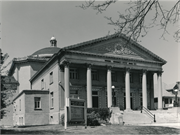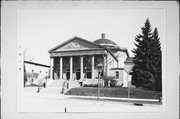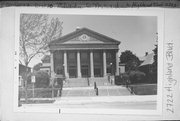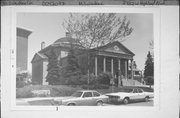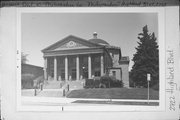Property Record
2722 W HIGHLAND BLVD
Architecture and History Inventory
| Historic Name: | Second Church Of Christ Scientist |
|---|---|
| Other Name: | St. Luke's Emmanuel Baptist Church |
| Contributing: | |
| Reference Number: | 42077 |
| Location (Address): | 2722 W HIGHLAND BLVD |
|---|---|
| County: | Milwaukee |
| City: | Milwaukee |
| Township/Village: | |
| Unincorporated Community: | |
| Town: | |
| Range: | |
| Direction: | |
| Section: | |
| Quarter Section: | |
| Quarter/Quarter Section: |
| Year Built: | 1913 |
|---|---|
| Additions: | |
| Survey Date: | 1984 |
| Historic Use: | house of worship |
| Architectural Style: | Neoclassical/Beaux Arts |
| Structural System: | Steel Frame |
| Wall Material: | Brick |
| Architect: | Carl Barkhausen |
| Other Buildings On Site: | |
| Demolished?: | No |
| Demolished Date: |
| National/State Register Listing Name: | Second Church of Christ Scientist |
|---|---|
| National Register Listing Date: | 1/16/1986 |
| State Register Listing Date: | 1/1/1989 |
| National Register Multiple Property Name: | Multiple Resources of West Side Area |
| Additional Information: | A 'site file' exists for this property. It contains additional information such as correspondence, newspaper clippings, or historical information. It is a public record and may be viewed in person at the Wisconsin Historical Society, Division of Historic Preservation-Public History. Description: The Second Church of Christ Scientist is a Pantheonic structure with a two-story portico and a copper lantern-topped dome. The building is centrally planned with an elongated portico on the south elevation. Ornament is limited to the six, fluted, limestone Corinthian columns, the glazed terra cotta ornament in the tympanum of the pediment and the enriched jambs of the entrances. Terra cotta cornices serve as the only decoration on the main body of the church and complement the tan face brick used throughout. The portico fronts a large scale vestibule which in turn opens to the main auditorium of the church. The square auditorium block with chamfered corners supports a cylindrical drum on which rests a low dome. True to the tenets of Christian Science, the interior is relatively plain except for a beautiful leaded glass skylight in the dome and the decorated north wall. This wall features a coffered apse with an organ balcony and it is here that the pulpit is situated. The apse is flanked by two shallow alcoves framed by paired Ionic columns supporting a rich entablature. The alcoves feature pierced ornamental grillwork. Pews are arranged in concentric arcs facing the pulpit. All of the interior furnishings are original as is the exterior. Architectural/Engineering Significance: It is significant as one of the few examples of Neoclassical church architecture in Milwaukee. Extant Neoclassical buildings in Milwaukee are essentially the product of early 20th century design and rely heavily on Roman prototypes. Examples of this are the Northwest Mutual Life Insurance Building (Marshall and Fox 1914), Gimbel's East Facade remodeling (Herman J. Esser 1925), and the Milwaukee County Court House (Albert R. Ross 1929-31) which feature monumental colonnades on raised basement stories and are essentially cubic or geometric in form. Neoclassical church structures are even fewer in number. Other than Second Church, other examples include First Church of Christ Scientist (S. S. Beman 1907-09) and Third Church of Christ Scientist (Frank Howard 1922-1924). More common at this time was the continued use of simplified Gothic forms and Georgian Revival style of ecclesiastical buildings. Ultimately descended from the second century A..D. Roman Pantheon as interpreted by Andrea Palladio (Villa Capri, Vancenza c. 1550), Second Church owes much to such well known American buildings as McKim, Mead and White's Madison Square Presbyterian Church in New York City (1906). Second Church's interpretation of classical forms sets it apart from the more abstracted and cubic First Church and Third Church. (See Historical Background for more information on architects). Historical Background: Milwaukee's contributions to establishing the Christian Science Church as a national denomination are recorded in the archives of the Mother Church in Boston. The records state that Milwaukee was the first city after the original organizations were founded in Lynn and Boston, Massachusetts to establish a Christian Scientist Association. The originals of the Christian Science Church can be traced to 1866 when its founder, Mary Baker Eddy, experienced a miraculous physical healing. She had slipped on the ice near her home in Lynn, Massachusetts and had seriously injured her back. Subsequently, her injury healded without medical treatment. She attributed this cure to her belief in spiritual metaphysics. Metaphysics is a science which therorizes that within the mind there are powers which can heal physical infirmities without the aid of medicine or surgery. News of other healings spread quickly resulting in a following eager to learn the science of metaphysics. In response to this, Mrs. Eddy established in her home, the first school of instruction for metaphysical healers in 1870. In 1879, the school was chartered by the State of Massachusetts as the first such institution of its kind anywhere. The culmination of this early period was the publication in 1875 of Mrs. Eddy's doctrine of spiritual metaphysics called "Health and Science." In the following year she established the first Christian Scientist Association in Lynn. Although the original concept of her doctrine did not include an organized church and heirarchy she was prompted by her growing number of followers and practicioners to establish the Mother Church in Boston in 1879. In 1883 Dr. Silas J. Sawyer, a Milwaukee dentist, and his wife Jenny, were trained under Mrs. Eddy as metaphysical healers and instructors of the religion. The Sawyers returned to Milwaukee in 1884 and started the Wisconsin Metaphysical Institute under a charter granted by the State. Sessions were held in Dr. Sawyer's office on East Wisconsin Avenue. In October of 1884 the Sawyers estabished the Chistian Scientist Association of Wisconsin. It was the only association of its kind in the United States other than the original ones in Lynn and Boston. The Association, which met in rented halls, was reorganized as the Church of Christ Scientist in 1889. Subsequently, the name was changed to Students Christian Scientists Association, No. 11. In 1889 the Association incorporated a church organization called CHURCH OF CHRIST SCIENTIST, which was subsequently changed to FIRST CHURCH OF CHRIST, SCIENTIST, MILWUAKEE, WISCONSIN. In 1901 the church decided to build an edifice on the east side at what is now 1036 North Van Buren Street. Complete records of the pioneer work done since 1884 were sealed in the cornerstone. The Gothic style building, completed in 1902, was deisgned by local architect Elmer Grey. This structure was listed in the National Register in 1980 for its association with the history of the Church in Wisconsin, as well as for its architecture. Between 1892 and 1903, the Second, Third, and Fourth Churches of Christ, Scientist were formed in various parts of Milwaukee, but by 1906 they had all merged with First Church. As a result, the congregation grew too large for the building on Van Buren Street, and in 1907 it was offered for sale. A minority of dissenting members, including the original pioneers of the church, incorporated as the CHRISTIAN SCIENCE SOCIETY OF MILWUAKEE, received recognition from the Mother Church in Boston, and purchased the original church edifice on Van Buren. Much later, in 1937, the Soceity applied for and was granted, the title of SIXTH CHRUCH OF CHRIST, SCIENTIST, MILWAUKEE, WISCONSIN, which explains why the oldest Christian Science church building in this city houses the most recently designed church. After selling the church building on Van Buren Street to the dissenters who left the congregation, the homeless First Church held services in the Pabst Theater until a new edifice, at what is now 1451 North Prospect Avenue, was completed in 1909. Although this monumental, classical structure, designed by the repsected architect, S. S. Beman of Chicago, could accommodate 1,200 persons, the rapidly-increasing congregation had outgrown this building before it was ever finished. The first of the spinoff congregations from the First Church was SECOND CHURCH OF CHRIST, SCIEINTST, MILWUAKEE organized and incorporated in 1909. Steadly-increasing attendance at its services which were held in the Plankinton Hall of the Milwaukee Auditorium, led to the erection of the present church building at 2722 West Highland Boulevard. This structure, designed by Carl Barkhousen of Milwaukee and completed in 1914, is also Neoclassical in style and is reminiscent of the Roman Pantheon. The building cost $135,000 and had a seating capacity of 1,450 persons. By 1917 even these accommodations proved inadequate and eventually four new congregations evolved in the Milwaukee area from Second Church: Third Church (1924 on North Sherman Blvd.), First Church Wauwatosa (1922), Fifth Church (1950 on South 30th St.) and Fourth Church (1929 on E. Kenwood Blvd.). In recent years the Christian Science movement in Milwaukee has experienced a decline. Second Church has been sold and its members have dispersed to other congregations. (B,C). |
|---|---|
| Bibliographic References: | A. Milwaukee City Building Permits. B. Milwaukee Landmarks Commission. "Historic Designation Study Report (Second Church of Christ Scientist). C. Milwaukee Landmarks Commission. Landmark Inventory - Nomination Form. 1979. D. MILWAUKEE HISTORIC BUILDINGS TOUR: WEST END, CITY OF MILWAUKEE DEPARTMENT OF CITY DEVELOPMENT, 1994. Spaces & Traces Open House Tour, Historic Milwaukee Inc., 2012. |
| Wisconsin Architecture and History Inventory, State Historic Preservation Office, Wisconsin Historical Society, Madison, Wisconsin |

